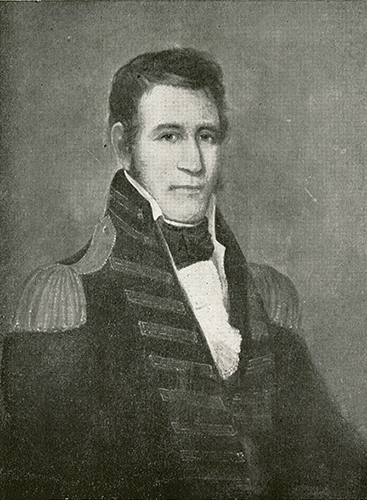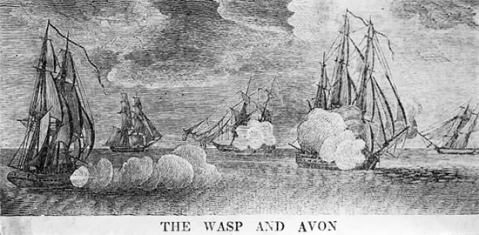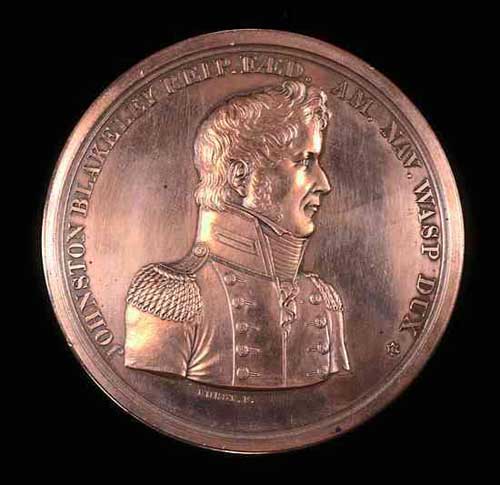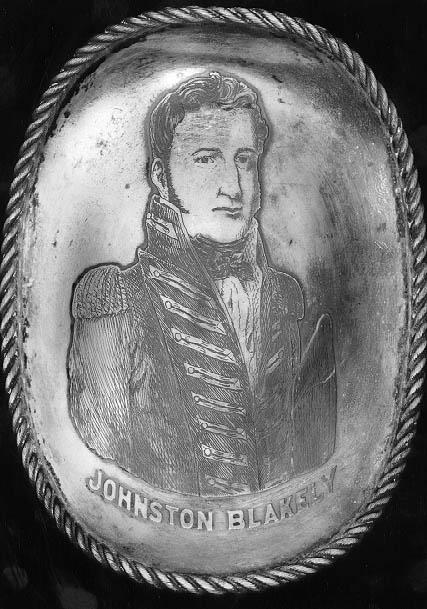Blakeley, Johnston
October 1781–October 1814
 Johnston Blakeley, naval officer and hero of the War of 1812, was born near the village of Seaford in County Down, Ireland. His father, John Blakeley, emigrated with his wife and son to Wilmington when Johnston was two years old; John Blakeley's wife died on the voyage, and he and his son lived together for many years in Wilmington. Blakeley was educated at a school in Flatbush, Long Island, and from 1797–99 attended The University of North Carolina, where he was president of the Philanthropic Society. When his father died, Blakeley became the ward of Edward Jones of Rockrest, Chatham County. Left without funds by a disastrous fire that destroyed the Blakeley warehouses in Wilmington, Blakeley sought a career in the U.S. Navy and was appointed midshipman on 5 Feb. 1800. He served in the Mediterranean during the war with the Tripoli pirates, under Captain John Rodgers and Commodore Stephen Decatur; he was commissioned lieutenant 10 Feb. 1807 and on 4 Mar. 1811 assumed command of the schooner Enterprise. When war with England was declared in 1812, Blakeley was stationed at the Norfolk Navy Yard, and later he was sent to New Orleans. Becoming restless, he asked Edward Jones to intercede for a more active command for him. Through the influence of Congressman William Gaston and Senator James Turner, he was transferred to New Hampshire, where, on 19 Aug. 1813, the Enterprise captured the British privateer schooner Fly off Cape Porpoise, in Blakeley's first exploit.
Johnston Blakeley, naval officer and hero of the War of 1812, was born near the village of Seaford in County Down, Ireland. His father, John Blakeley, emigrated with his wife and son to Wilmington when Johnston was two years old; John Blakeley's wife died on the voyage, and he and his son lived together for many years in Wilmington. Blakeley was educated at a school in Flatbush, Long Island, and from 1797–99 attended The University of North Carolina, where he was president of the Philanthropic Society. When his father died, Blakeley became the ward of Edward Jones of Rockrest, Chatham County. Left without funds by a disastrous fire that destroyed the Blakeley warehouses in Wilmington, Blakeley sought a career in the U.S. Navy and was appointed midshipman on 5 Feb. 1800. He served in the Mediterranean during the war with the Tripoli pirates, under Captain John Rodgers and Commodore Stephen Decatur; he was commissioned lieutenant 10 Feb. 1807 and on 4 Mar. 1811 assumed command of the schooner Enterprise. When war with England was declared in 1812, Blakeley was stationed at the Norfolk Navy Yard, and later he was sent to New Orleans. Becoming restless, he asked Edward Jones to intercede for a more active command for him. Through the influence of Congressman William Gaston and Senator James Turner, he was transferred to New Hampshire, where, on 19 Aug. 1813, the Enterprise captured the British privateer schooner Fly off Cape Porpoise, in Blakeley's first exploit.
Blakeley was promoted to command of the Wasp, under construction at Newburyport, described by one of its officers as "a beautiful ship, and the finest sea-boat, I believe, in the world." She carried twenty carronades and two long twelve-pounder guns, with a crew of 173. Blakeley was given sealed orders to sail to western Europe and create as much havoc as he could against British shipping, then to sail south to the Spanish coast, where the British were fighting Napoleon's armies, and finally to return to New Orleans.
 Quickly the Wasp captured the brigs Lettice and Bon Accord. Blakeley sighted a fleet of ten sail on 1 Sept., cut out and burned the brig Mary, laden with military stores, but was driven off by a seventy-four-gun frigate guarding the convoy. In the late evening of the same day he sighted four more sail and engaged the heavy brig Avon in a bitter fight lasting forty-seven minutes. The approach of three other brigs forced him to leave after receiving the surrender of the Avon but before his crew could board it. The Wasp drew off safely to repair her damage.
Quickly the Wasp captured the brigs Lettice and Bon Accord. Blakeley sighted a fleet of ten sail on 1 Sept., cut out and burned the brig Mary, laden with military stores, but was driven off by a seventy-four-gun frigate guarding the convoy. In the late evening of the same day he sighted four more sail and engaged the heavy brig Avon in a bitter fight lasting forty-seven minutes. The approach of three other brigs forced him to leave after receiving the surrender of the Avon but before his crew could board it. The Wasp drew off safely to repair her damage.
A lean three weeks followed, after which good fortune came again. Having seized the brigs Three Brothers and Bacchus, the Wasp captured the Atalanta, which was laden with wine, brandy, and silk. Since there was some doubt as to the nationality of the Atalanta, Blakeley did not follow his usual custom of burning her but instead put Midshipman David Geisinger and a prize crew aboard. On 22 Sept. 1814 the Atalanta set sail to Savannah, Ga., where she arrived safely in November. No further word was ever received from the Wasp.
 Rumors flew to account for the mysterious disappearance of the valiant vessel. A privateer claimed to have seen the Wasp off the Canary Islands. The British frigate Lacedemonian was believed by some to have sunk her off Charleston, S.C. John C. Calhoun heard a report that she was operating in the Pacific Ocean. Blakeley was promoted to post captain, but he and his men never returned.
Rumors flew to account for the mysterious disappearance of the valiant vessel. A privateer claimed to have seen the Wasp off the Canary Islands. The British frigate Lacedemonian was believed by some to have sunk her off Charleston, S.C. John C. Calhoun heard a report that she was operating in the Pacific Ocean. Blakeley was promoted to post captain, but he and his men never returned.
Blakeley was married in Boston to Jane Ann Hoope on an unknown date; they had one child, a daughter named Udney Maria, born in January 1815 after her father's disappearance. His widow remarried in 1820 and eventually moved to the island of St. Croix, where she had lived for a time as a child. Congress voted Blakeley a gold medal, and the North Carolina legislature in 1816 authorized a sword to be given to Mrs. Blakeley and offered to pay for the education of his daughter. Mrs. Blakeley suggested that a silver tea service would be more suitable for Udney Maria; accordingly, a suitably inscribed service was presented. The daughter attended school in Philadelphia, remaining there until 1829. She joined her mother in St. Croix, married Baron Joseph von Bretton in 1841, and died in childbirth together with her infant, 2 Mar. 1842.
Blakeley's portrait is at the Philanthropic Society Hall at The University of North Carolina in Chapel Hill. A poem written in 1854 may serve as a fitting epitaph:
No more shall Blakeley's thunder roar
Upon the stormy deep;
Far distant from Columbia's shore
His tombless ruins sleep;
But long Columbia's song shall tell
How Blakeley fought, how Blakeley fell.
References:
DAB, vol. 3 (1929).
William Johnson, "Biographical Sketch of Capt. Johnston Blakel(e)y," University of North Carolina Magazine 2nd ser. 3 (1854).
S. M. Lemmon, Frustrated Patriots: North Carolina and the War of 1812 (1973).
National Archives, Record Group 45.
A. R. Newsome, "Udney Maria Blakeley," North Carolina Historical Review 4 (1927).
North Carolina Booklet 1 (1901).
Additional Resources:
Captain Johnston Blakeley in the New Georgia Encyclopedia: http://www.georgiaencyclopedia.org/nge/Multimedia.jsp?id=m-7938
Johnston Blakeley, War of 1812 Hero, Lost at Sea, This Day in North Carolina History, North Carolina Department of Cultural Resources: http://nchistorytoday.wordpress.com/2013/05/01/johnston-blakeley-war-of-1812-hero-lost-at-sea/
Blakely History, Dictionary of American Naval Fighting Ships: http://www.history.navy.mil/danfs/b7/blakely-blakeley-i.htm
The Papers of Archibald D. Murphey: Public papers. Historical, biographical, and literary papers. Papers on the North Carolina-Tennessee land controversy. Petition of Rev. John Debow to the General Assembly, 1777. Appendix. E.M. Uzzell & Company, State printers, 1914. http://books.google.com/books?id=7DYTAAAAYAAJ&dq=johnston+blakeley&source=gbs_navlinks_s&printsec=frontcover#v=onepage&q&f=false (accessed May 8, 2013).
Captain Johnston Blakeley Naval Medal, the New York Historical Society: http://www.nyhistory.org/exhibit/captain-johnston-blakeley-naval-medal-1
"Captain Johnston Blakeley." N.C. Highway Historical Marker H-10, N.C. Office of Archives & History. https://www.ncdcr.gov/about/history/division-historical-resources/nc-highway-historical-marker-program/Markers.aspx?sp=Markers&k=Markers&sv=H-10 (accessed May 8, 2013).
Image Credits:
Unidentified artist, circa 1840. "Johnston Blakeley, 1781-1814." North Carolina Portrait Index, 1700-1860. Chapel Hill: UNC Press. p. 25. (Digital page 39). https://www.worldcat.org/title/832326?oclcNum=832326. Accessed 10/14/2014.
"Ornament, Accession #: H.19XX.320.2." 1815-1900. North Carolina Museum of History.
"Commemorative Medal, Accession #: H.19XX.320.4." 1814. North Carolina Museum of History.
"Photograph, Accession #: H.19XX.135.40." 1900. North Carolina Museum of History.
1 January 1979 | Lemmon, Sarah McCulloh
